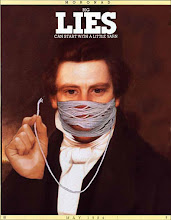Masonic Origin:
The Mormon temple ritual (the "endowment") is very similar to the Masonic initiation ceremony of the 1840s. Joseph Smith (the Mormon prophet) introduced it to his followers two months after he himself was initiated into Freemasonry.
Changes:
The endowment ceremony had to be "restored" to the original and pure form that it had in Adam's time, according to Smith, because the Masons had "corrupted" the ceremony by removing and changing many parts. Since the 1840s, the Mormon prophets have continued to change it from the pure form given by Joseph Smith, by removing and changing many parts.
Secret Handshakes:
The most secret part of the endowment ritual is learning the four secret handshakes and passwords that Mormons believe will be required for admission into the presence of God.
Death Oaths:
Until 1990, the endowment ritual included oaths of secrecy in which the initiates mimicked the taking of their own lives (by slitting the throat and by disembowelment) if they ever revealed the secret handshakes and passwords.
Everything for the Mormon church:
One of the oaths included in the endowment ritual is a promise to give everything you have, including your life, to the Mormon church, if asked. (This oath was invoked recently to persuade some reluctant Mormons to help finance the campaign for the initiative against same-sex marriage in California.)
Other Oaths:
As part of the ritual, Mormons also take an oath to obey the "Law of Obedience" (to obey church leaders) and to "speak no evil of the Lord's anointed [i.e., the church leaders]."
Families Together?
Since only worthy Mormons can enter the temple, Mormon temple weddings exclude non-Mormon family members, even parents of the bride and groom. No music, no poetry, no photographs are allowed during the short wedding ceremony in the temple. (Although the bride may wear a traditional white wedding gown, she must wear the ritual temple clothing over the gown.) Although Mormons teach "family togetherness," in practice many Mormons shun family members who leave the church, and a Mormon spouse who no longer believes is often divorced. In other words, Mormonism often breaks families up.
Polygamy ("Plural Marriage"):
Although Mormons officially abandoned the practice of polygamy in 1890, it continued to be practiced in secret well into the 20th century and is still part of their doctrine (see the Mormon scripture Doctrine & Covenants, Section 132). It is still possible, under certain circumstances, for a Mormon man to be married in the temple "for eternity" to more than one wife. Thus, there will be polygamy in Mormon Heaven.
Racism:
Until 1978, persons with any trace of black African ancestry were not permitted to enter a temple, even if they were otherwise "worthy" members of the church.
Your Ancestors Are Now Mormons?
Most Mormons attending the temple rituals are doing so as proxies for the dead, in order to qualify the dead for admission to the Mormon heaven. Probably most of your ancestors have already been posthumously inducted into the Mormon church. The Mormons have done this for millions of dead people (this is the primary purpose of their extensive genealogical research), including deceased presidents of the U.S., many Catholic saints, and even Adolf Hitler.
Mormon Underwear:
Mormons who have been through the endowment ritual are required afterwards always to wear special white underwear (the "garment") with Masonic markings. They believe that this protects them from physical harm and from Satan.
Contradictions?
Although the Mormon holy book The Book of Mormon, published in 1830, was said by Joseph Smith to include the "fulness of the Gospel," it says not a single word about the endowment or about doing proxy rituals to save the dead. In fact, it specifically says that you must be saved before you die, otherwise it's too late. (Alma 34:34, 2 Nephi 9:38)
Subscribe to:
Post Comments (Atom)




No comments:
Post a Comment